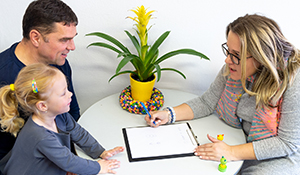By Tara Moser, MSW, LCSW
When you get home from a stressful day, what is the first that you think? Do you look forward to debriefing with a loved one, calling a friend to vent, or taking a run to let off steam? These are all positive ways to reduce stress. However, for many it is relaxing to come home to a pet that is eagerly waiting at the door for you. Pets love you unconditionally and even more so when they sense discomfort.
Therapeutic animals have been successful in nursing homes, hospice, physical rehabilitation facilities, group homes, and hospitals. They have long been used as companion animals, assisting people with various disabilities, enabling them to lead more independent lives. Therapeutic and companion animals do not have to be dogs, although they are the ones with which we are most familiar. Cats, ferrets, birds, and other animals have also been used with success. Even a fish in a fishbowl placed next to the bed of a person in a hospital has been known to help.
Pets often provide a personal therapist at home, as well as being used in a more formal therapeutic setting. At home pets sit and listen without judgment. They allow you to cry. They console you when you don’t really know you need it. Pets are able to read your emotions through your body movements and tone. In a formal setting, pets are beneficial in processing situations that have occurred. At times, the presence of a pet can bring soothing comfort to allow relaxation toward processing.
If pets are being used to help children and teenagers deal with stress, the young people should feel comfortable with the pet,usually a dog, and certainly not be at all afraid of the animal. The size of the dog could be important for some children as they may fear larger dogs. If you are using a therapeutic dog in your home, your dog should be a comfortable and familiar size.
Abbey and Bode
Two professional therapeutic dogs, Abbey , a 20 lb. beagle mix, and Bode, a 110 lb. Great Dane mix have been extremely effective in therapy with children. Choosing which dog comes to work is dependent on their mood that day as well as the child scheduled to work with them.
Recently, Abbey came into a therapy session with a child who no longer lives with his biological family. With the child and guardian’s permission, Abbey came to work with the middle-school-age child. With this particular child, it was important to know about Abbey’s history. Abbey was a rescue and was not able to stay with her mother anymore. This child began to identify similarities between the dog’s life and his own. The child recognized that they have been through many similar things and are doing well with the love from their new families. Abbey was calm with the child and mostly sat near and nudge for a rub or kiss the child when Abbey felt he needed reassurance that everything is alright.
Bode helped a seven year old with fears after a trauma. At first Bode’s size was intimidating to the child; however she soon decided that he looked like “Scooby-Doo”. In this case, the name of the dog was not important and the child felt more comfortable referring to him as Scooby-Doo, rather than Bode. The human therapist was replaced by “Scooby-Doo”, processing the child’s feelings.
The child discussed needing friends and she included the dog in her play. Bode joined her at the play kitchen where they made tea and cookies and sat down to a pretend snack. As the therapist asked questions, the child answered the dog. The child discussed her fears and asked the dog how he was able to overcome his.
When a noise startled the large dog, the girl became empowered and she was able to console him and talked about how she and the therapist would keep him safe. After this processing, the child told the therapist she realized now that she needed to trust her mom and other family members that they would keep her safe from any harm. With Bode’s large size, he provided a solid hug for the client during and at the end of session, to which she stated to the mother he was her new friend.
Abbey and Bode have been helpful with children in other ways. They have been able to aid in discussing changes in client’s behaviors, such as a child that has been diagnosed with bipolar disorder and is cycling through manic and depressive mind frames; to increase positive self-talk to prevent self harm; anger management; and come into sessions as a reward for making counseling goals.
Conclusion
How can your own pet become more “therapeutic”? Animals respond to tone and thus will not assist you if your tone is angrily directed toward them. Simply talking to your pet about your day will allow you to get out your feelings. Pet them for the physical connection that soothes your body by contact with them. Playing or teaching a new trick with help redirect negative thoughts to more positive thoughts of the pet and turn negative energy into a positive learning experience.
There are many roles for “man’s best friend” and being your source of comfort is one. If you do not have a pet or your pet does not provide you with what you need, visit with a friend that has a dog or cat or find another outlet to express yourself in non-judgemental ways. Remember that you can provide for a pet as much as they can provide for you. There are many local shelters and rescues with amazing animals that need a loving home.
Ms. Tara Moser, LCSW, is a therapist at Delta Family Counseling, LLC.





